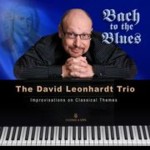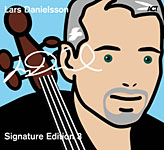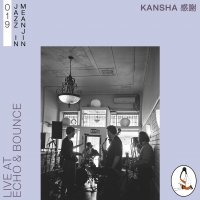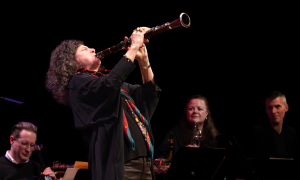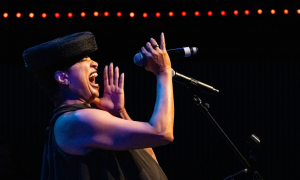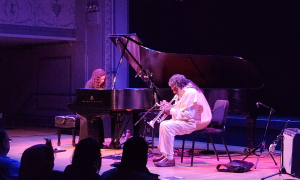Home » Jazz Articles » Live Review » Paul Austerlitz Quintet at El Taller Latino Americano 3/06/10
Paul Austerlitz Quintet at El Taller Latino Americano 3/06/10
El Taller Latino Americano
New York, New York
March 6, 2010
 The Paul Austerlitz Quintet made a rare New York appearance at El Taller Latino Americano, a performance space and showcase for artistic talent on Manhattan's upper west side. The occasion marked the introduction of music based on Dominican rhythms and was sponsored by the Mellon Foundation and the Sundeman Conservatory of Music at Gettysburg College, where Austerlitz teaches ethnomusicology and Africana Studies. The concert also featured new pieces written for a grant from the American Composers Forum, original works that had been premiered in Philadelphia earlier this week.
The Paul Austerlitz Quintet made a rare New York appearance at El Taller Latino Americano, a performance space and showcase for artistic talent on Manhattan's upper west side. The occasion marked the introduction of music based on Dominican rhythms and was sponsored by the Mellon Foundation and the Sundeman Conservatory of Music at Gettysburg College, where Austerlitz teaches ethnomusicology and Africana Studies. The concert also featured new pieces written for a grant from the American Composers Forum, original works that had been premiered in Philadelphia earlier this week.
For the event the reed player and bass clarinetist assembled a consortium of forward-thinking musicians, including pianist Richard Johnson (who performed regularly with Wynton Marsalis), bassist and young lion Eric Wheeler, master drummer, percussionist and bandleader Babatunde Lea and visionary drummer, song-writer, singer and dancer Jose Duluc, all of whom played an important role in a joyous and transcendental conversation with their audience.
The evening's festivities commenced with East Broadway Merengue, a tune inspired by the Sonny Rollins recording East Broadway Rundown and which fuses jazz and the Dominican rhythm known as Pambiche. It was followed by Underground Palo, which represents the most widely diffused Afro Dominican ritual music throughout the Dominican Republic (not to be confused with Cuban Palo). The tune takes its inspiration from John Coltrane's Song of the Underground Railroad, which was inspired by the African-American spiritual, Follow the Drinking Gourd (code for the Big Dipper, a constellation that points north and to freedom). Thunderflow, a traditional Yoruba Cuban song dedicated to the Orisa (Orisha) Sango (Chango), was combined with the rarely heard Pri Pri rhythm. The tune featured Jose Duluc on the Balsie (Talking) drum, with tones manipulated by the movement of the player's foot.
Changing the pace, the quintet offered prayers for the victims of the Haitian earthquake. After this interlude, the band played a traditional song—invoking Haitian-Dominican spirits and known as Lwa. The theme revolved around the indivisible bond between Haiti and the Dominican Republic. During one section Jose Duluc donned a Rara dress, worn in processional ceremonies during Lent. Finally, the band brought the audience to its feet with a joyous merengue, Juanita Morel, and came full circle with a closing invocation to the Orisas.
Paul Austerlitz has had a long-standing relationship with Dominican music. Born in Finland and raised in New York City, he was exposed to Latino culture at a young age; however, he had no contact with Dominican music until he returned to New York in the 1980s after graduating from Wesleyan University. As an aspiring saxophonist with a deep love for Afro-Caribbean music he joined a Latin Jazz band but work was scarce. At the time a popular form of Dominican music known as merengue was taking New York City's Latin club by storm and there was as shortage of merengue saxophonists in the city. Shortly thereafter, Austerlitz started playing with merengue bands. As he became more committed to the music he moved to Washington Heights, where he learned to speak Spanish and participated in occasional gigs with first-rate musicians, including Jose Mateo and the King of Merengue. His work as an ethnomusicologist includes the books: Jazz Consciousness: Music, Race and Humanity (2005, Wesleyan University Press) and Merengue: Dominican Music and Identity (1997, Temple University Press).
Though no stranger to Afro Caribbean music, I was rendered speechless by the power, beauty and communal nature of Austerlitz' music. Asked during a recent telephone conversation to describe his music, he modestly told me that it is "Jazz with Afro Dominican and Haitian influences." Left wanting more, I went to the liner-notes for Journey (Innova Records), where the following passage, written in the leader's hand, stood out: "I believe that music is rooted in conversation and African based rhythms. The drum speaks and we respond by dancing outwardly (as in merengue) or inwardly (to more meditative sounds). I offer the creative fruit of my ethno musicological journey as a universal communion."
Photo credit
Courtesy of Paul Austerlitz
Tags
About Paul Austerlitz
Instrument: Multi-instrumentalist
PREVIOUS / NEXT
Support All About Jazz
 All About Jazz has been a pillar of jazz since 1995, championing it as an art form and, more importantly, supporting the musicians who make it. Our enduring commitment has made "AAJ" one of the most culturally important websites of its kind, read by hundreds of thousands of fans, musicians and industry figures every month.
All About Jazz has been a pillar of jazz since 1995, championing it as an art form and, more importantly, supporting the musicians who make it. Our enduring commitment has made "AAJ" one of the most culturally important websites of its kind, read by hundreds of thousands of fans, musicians and industry figures every month.



